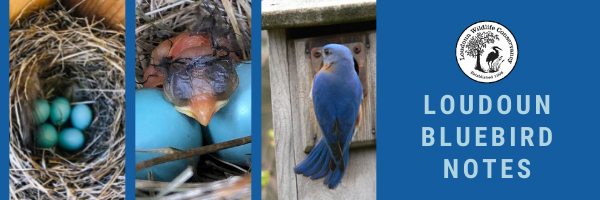Bluebird Nestbox Monitoring
Why Do We Monitor Bluebirds?
Beginning in the early 1900s, Eastern Bluebird populations underwent such a precipitous decline that many feared extinction was inevitable. Reasons for the decline included loss of habitat, pesticide use, and the introduction of House Sparrows and European Starlings into America. Both species are cavity nesters (as are bluebirds) and are extremely competitive and aggressive. In 1978 the North American Bluebird Society was formed by citizen scientists to promote the conservation of bluebirds and other native cavity nesters. They set up a network of bluebird nestbox trails, educated the public and trained volunteers as monitors. As a result, Eastern Bluebirds have made a comeback.
Loudoun Wildlife Conservancy volunteers monitor 57 nestbox trails comprising nearly 700 nestboxes throughout Loudoun County. Our program is one of the largest in Virginia, recording more than 3000 cavity-nester fledglings annually. By monitoring the boxes, we collect information on our native cavity nesters, learn about their lives first hand and track population trends. The data we collect is submitted to the Virginia Bluebird Society.
How to Get Involved: Nestbox Monitoring
Monitoring our public trails is done in teams of four so that each person monitors about once per month, April through August. Each trail has a trail leader who creates the monitoring schedule, coaches new monitors, identifies trail repairs and compiles the data at the end of the season and sends it in to Loudoun Wildlife Conservancy’s Bluebird Program Data Coordinator.
Alternatively, you could set up and monitor your own home trail once a week through the season. At the end of the season, compile the data and send it in.
If you’d like to help with monitoring, please sign up here. All levels of experience are welcome. We provide hands-on training for monitors each March, just before the monitoring season begins.
Our newsletter,  Loudoun Bluebird Notes, is published online for our nestbox trail monitors. The newsletter has articles about cavity nesters, trail monitors, and tails from the trails along with beautiful photographs from our contributors. In addition, the newsletter offers tips on how to deal with predators and provides answers to frequently asked questions.
Loudoun Bluebird Notes, is published online for our nestbox trail monitors. The newsletter has articles about cavity nesters, trail monitors, and tails from the trails along with beautiful photographs from our contributors. In addition, the newsletter offers tips on how to deal with predators and provides answers to frequently asked questions.
Learn More
Our Work
Citizen Science News
-
The Monitor Archive The first edition of Loudoun Wildlife Conservancy’s monthly stream monitoring...
Read More -
Winged Mammals: Exploring the Fascinating World of Bats On March 24, Loudoun Wildlife Conservancy partnered with Loudoun County...
Read More -
Hands-on Training for Bluebird Monitors Held on March 17 Photo by Sharon Crowell On Sunday March 17, 30 Bluebird...
Read More

